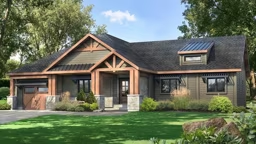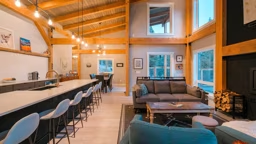
We’ve got the inside scoop architects and designers share with their clients as they walk them through the process.
Location
Location, the granddaddy of all design decisions, is just as important for aging in place clients as it is for any other client. Location of the home with respect to emergency services (like fire and EMS), neighbors who may also be caretakers, social and recreational activities, family and friends (children and grandchildren), etc. are of critical importance.
Steve Lykins, Director, Architecture & Engineering, Hochstetler Log Homes
Affordability
Aging in place usually means living on a fixed income, so long-term affordability is essential. Maintenance, property taxes and insurance can vary widely and can wreak havoc on a fixed income. It is important to consider and address these items early.
Steve Lykins, Director, Architecture & Engineering, Hochstetler Log Homes
Designing
Get the most for your money. A one-level design with a finished basement that can easily be accessed by its own separate point of entry from the main floor will serve you well now and later, as will 3-foot interior doors, spacious closets, an open-concept main living area and plenty of outdoor living space!
Jeremy Elliott, Sales Representative, Coventry Log Homes
Try to have everything you’d need to live on one level, including your bedroom, bathroom, laundry, kitchen, dining room and garage access. As we age, our joints ache and traveling up and down stairs can be difficult.
Matt Franklin, Lead Architect, M.T.N Design
I find most of my clients who are preparing to age in place have different lifestyles than they did when they were 30 or 40 years old with children. Aging-in-place clients might consider a guest room or suite with bathroom and lounge for a live-in caretaker, as well as a washer/dryer in the primary bedroom closet so laundry doesn’t have to be moved around the house needlessly.
Steve Lykins, Director, Architecture & Engineering, Hochstetler Log Homes
Kitchen
Choose your appliances wisely. For example, a drawer microwave is much safer for the elderly to use than pulling down hot dishes from an upper-cabinet unit.
Matt Franklin, Lead Architect, M.T.N Design
Bathroom
If you’re independently mobile (you don’t require a wheelchair or other form of assistance) and you want the privacy of an enclosed toilet in your primary bath, design the bathroom in a way that one or two of those water-closet walls can be removed with minimal remodeling, so that you can have open access to the toilet if the need arises. This applies to shower spaces, too. And as you’re designing the floor plan, look for possible choke points in travel paths.
Matt Franklin, Lead Architect, M.T.N Design
Garage
In regards to garages, there is often a big difference in elevation from the garage to the main floor, especially on sloped lots. Design the home in such a way that the difference is minimal or eliminated altogether.
Matt Franklin, Lead Architect, M.T.N Design
In single-level houses without steps, garages require careful detailing of a 6-inch high ramp, so carbon monoxide and other combustion gases (which are heavier than air) don’t make it into the home.
Steve Lykins, Director, Architecture & Engineering, Hochstetler Log Homes
Maintenance
Once the interior design is perfected, ease of maintenance as we age is key. Minimize upkeep by including larger roof overhangs to protect exterior walls, rain gutters and add good drainage/protection apron around the perimeters of the house.
Jeremy Elliott, Sales Representative, Coventry Log Homes











